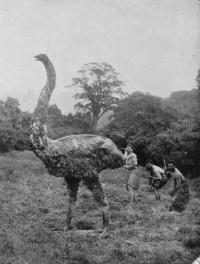Home-Tiniroto through the looking glass
- Team Tiniroto
- Research process
- Learning outcomes
- Moa at Tiniroto
- Legend of Whakapunake
- The legend of our rivers
- Te Kooti in Tiniroto
- Farming history in Tiniroto
- Schools in Tiniroto
- The history of the Tiniroto Tavern
- The Army in Tiniroto
- Communication over the years
- Ruakaka Station
- Earthquakes in Tiniroto District
- Fighting fires
- Community Hall
- Te Roto
- Te Awa
- Native birds
- Our maunga
- Tiniroto landscapes
- Remembered for?
- References and acknowledgements
Moa at Tiniroto
The moa was called the fire bird or ahi manu. It is thought this is because of the fires that people used to burn to try and chase the moa into big pits that had been dug out.
We know that moa existed in Tiniroto because people have found the bones.
Some were found in a swamp. It was called ‘Moa Swamp’ on Tiniroto Station.
Here is one of the moa bones found at Tiniroto Station.
DNA evidence shows there were two main types of moa and that they liked to live in caves. Mt Whakapunake has many caves.
Moa were plentiful at Tiniroto because they had lots of food they liked to eat, for example twigs and leaves from low trees. They were here because it was remote and there weren't many people.
We asked local people about what they knew. People told us that when the people from Manutuke came to get moa and the fires were burning, the local iwi from Te Reinga would come to Tiniroto and chase them off!
Hunters around Tiniroto chased the moa over bluffs around Whakapunake. They took the meat down to the river and lit fires to prepare the meat to take back home. Manutuke hunters had to be very careful because the local Maori from Te Reinga would come to take back the meat.
We contacted Mr Gordon Jackman. He is a geologist who has lived many years in Tiniroto. According to Maori tradition Whakapunake was the last refuge of the moa. There is archaeological evidence the moa could still have been present in the district in the 1500’s (which is two hundred years after they died out in the rest of the country!).
Moa footprints were found (and are still held in the Tairawhiti Museum) in the sandstone near Waikanae stream in Gisborne.
The other legacy of the moa’s may be the roads. The oldest map of Tiniroto has on it marked “Maori Walking Trail” part of which the road from school to the top of the hill going towards Gisborne is based on. It is very likely that when Maori first came to the area they used moa trails to walk the bush. These trails would have formed over hundreds of thousands of years as moa were big birds and they would have collectively blazed the most efficient routes.
By Levi, Reuben and Crevice
See the geological report at: http://www.tandfonline.com/doi/abs/10.1080/03014220809510557#.Ua1x7mcZm9s







